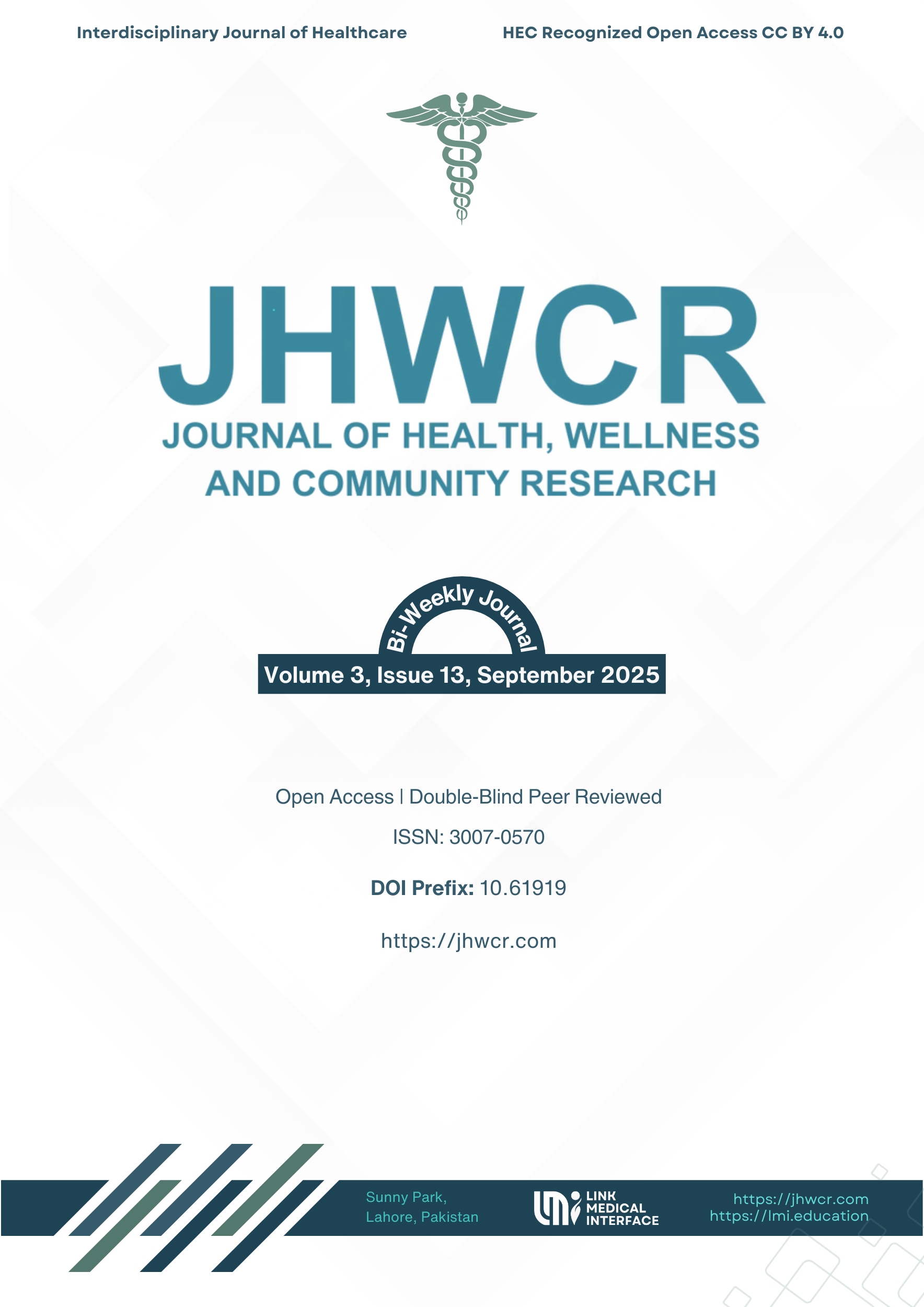Unlocking Paeonia emodi’s Phytochemical Potential: Extraction, Quantification, and Bioassay Studies
DOI:
https://doi.org/10.61919/4nzm4d83Keywords:
Paeonia emodi; antiglycation; alpha-amylase; alpha-glucosidase; PTP1B; polyphenols; IC50; diabetes mellitusAbstract
Background: Type 2 diabetes features postprandial hyperglycaemia, impaired insulin signalling, and glyco-oxidative stress. Approaches that simultaneously attenuate intestinal carbohydrate digestion, enhance insulin receptor signalling, and limit advanced glycation end-products (AGEs) may offer superior benefit. Objective: To quantify phytochemical constituents of Paeonia emodi roots and assess multitarget antidiabetic activities—antiglycation, α-amylase and α-glucosidase inhibition, and PTP1B inhibition—across phytochemical classes and solvent fractions. Methods: Roots were ethanolic-extracted and successively fractionated with n-hexane, chloroform, ethyl acetate, and methanol. Total flavonoids, phenolics, and tannins were measured by AlCl₃ and Folin methods; alkaloids were determined gravimetrically. Bioactivities were evaluated in microplates: BSA–glucose antiglycation (Ex/Em 370/440 nm), α-amylase (DNS endpoint, A540), α-glucosidase with pNPG (A405), and PTP1B with pNPP (A405). IC₅₀ values were obtained by nonlinear regression with appropriate controls and replication. Results: P. emodi contained high flavonoids (852.67 ± 64.97 µg/mL) and tannins (394.00 ± 13.02 µg/mL), with lower phenolics (98.59 ± 29.71 µg/mL). Flavonoids displayed the strongest antiglycation effect (IC₅₀ 14.61 ± 0.93 µg/mL), while the n-hexane fraction was the most potent antiglycation extract (9.52 ± 0.34 µg/mL). For α-amylase, phenolics were most active (8.28 ± 1.07 µg/mL) and n-hexane and ethyl acetate fractions were superior (5.99 ± 0.20 and 6.09 ± 1.16 µg/mL), exceeding acarbose (20.54 ± 1.07 µg/mL). Tannins most strongly inhibited PTP1B (4.27 ± 0.20 µg/mL), and the methanol fraction was the most active extract (4.29 ± 0.26 µg/mL), followed by n-hexane (6.73 ± 0.05 µg/mL). For α-glucosidase, phenolics led among classes (5.50 ± 0.56 µg/mL), while n-hexane and methanol fractions were most potent (4.85 ± 0.06 and 5.85 ± 0.69 µg/mL). Conclusion: Paeonia emodi demonstrates a coherent multitarget antidiabetic profile. Non-polar fractions concentrate inhibitors of postprandial pathways (α-amylase/α-glucosidase and antiglycation), whereas polar fractions are enriched for PTP1B inhibition. These complementary mechanisms justify bioassay-guided isolation and standardization efforts toward phytopharmaceutical development for diabetes management.
References
1. Chatterjee S, Khunti K, Davies MJ. Type 2 Diabetes. Lancet. 2017;389(10085):2239–2251.
2. Cho NH, Shaw JE, Karuranga S, Huang Y, da Rocha Fernandes JD, Ohlrogge AW, et al. IDF Diabetes Atlas: Global Estimates Of Diabetes Prevalence For 2017 And Projections For 2045. Diabetes Res Clin Pract. 2018;138:271–281.
3. International Diabetes Federation. IDF Diabetes Atlas. 7th ed. Brussels: International Diabetes Federation; 2015.
4. Sales PMS, Souza PM, Simeoni LA, Magalhães P, Silveira D. Inhibition Of Alpha-Amylase And Alpha-Glucosidase By Plant Extracts And Phytochemicals: A Systematic Review. Planta Med. 2012;78(8):1–12.
5. Ahamad J, Naquvi KJ, Mir SR, Ali M, Shuaib M. Alpha-Glucosidase Inhibitors From Medicinal Plants: A Review. Pharmacogn J. 2011;3(22):65–73.
6. Tamrakar AK, Maurya CK, Rai AK. PTP1B Inhibitors For Type 2 Diabetes Treatment: A Patent Review 2011–2014. Expert Opin Ther Pat. 2014;24(10):1101–1115.
7. Bakke J, Haj FG. Protein-Tyrosine Phosphatase 1B Substrates And Metabolic Regulation. Trends Endocrinol Metab. 2015;26(6):305–314.
8. Haj FG, Zabolotny JM, Kim YB, Kim HJ, Shulman GI, Kahn BB, et al. Regulation Of Insulin Receptor Signaling By Protein-Tyrosine Phosphatase 1B. J Biol Chem. 2005;280(2):1022–1029.
9. Liu S, Ishikawa Y, Okazaki Y, Yoshida M, Yamashita T, Yokoi N, et al. Protein Tyrosine Phosphatase 1B Negatively Regulates EphA5-Mediated Insulin Secretion In Pancreatic Islets. J Biol Chem. 2014;289(32):22070–22082.
10. Skyler JS, Bakris GL, Bonifacio E, Darsow T, Eckel RH, Groop L, et al. Differentiation Of Diabetes By Pathophysiology, Natural History, And Prognosis. Diabetes. 2017;66(2):241–255.
11. Xiao JB, Högger P. Dietary Polyphenols And Prevention And Management Of Type 2 Diabetes. Nutrients. 2015;7(8):5489–5506.
12. Barros L, Baptista P, Ferreira ICFR. Effectiveness Of AlCl3 And Folin–Ciocalteu Methods For Quantifying Flavonoids And Phenolics In Plant Extracts. Food Chem. 2008;110(4):1040–1045.
13. Akindahunsi AA, Oyetayo FL. Nutritional And Antioxidant Properties Of Tannins In Selected Tropical Plant Foods. Afr J Biotechnol. 2006;5(5):373–379.
14. Edeoga HO, Okwu DE, Mbaebie BO. Phytochemical Constituents Of Some Nigerian Medicinal Plants. Afr J Biotechnol. 2005;4(7):685–688.
15. Ayatollahi AM, Ghiaci M, Dabbagh H, Mollazadeh S. A Microplate-Based BSA–Glucose Assay For Antiglycation Screening. J Pharmacol Toxicol Methods. 2010;61(2):181–186.
16. Xiao J. A Microplate DNS Method For Alpha-Amylase Inhibition Assay With Improved Throughput. Carbohydr Res. 2015;413:12–15.
17. Rouzbehan S, Moeini R, Ghasemi A. Microplate Assay For Alpha-Glucosidase Inhibition Using p-Nitrophenyl-α-D-Glucopyranoside. J Appl Biol Sci. 2017;11(3):1–6.
18. Cui L, Naik MU, Naik UP, Friesel R. A Simple Microplate Assay For Protein Tyrosine Phosphatase 1B Using p-Nitrophenyl Phosphate. Anal Biochem. 2006;353(2):181–186.
19. Ghayur MN, Gilani AH, Rasheed H, Khan A, Iqbal Z, Ismail M, et al. Cardiovascular And Airway Relaxant Activities Of Peony Root Extract. Can J Physiol Pharmacol. 2008;86(11):793–803.
20. Zargar BA, Rather AA, Bhat ZA, Dar MY. Paeonia Emodi Royle: Ethnomedicinal Uses, Phytochemistry, And Pharmacology. Phytochem Lett. 2013;6(2):261–266.
21. Miller GL. Use Of Dinitrosalicylic Acid Reagent For Determination Of Reducing Sugar. Anal Chem. 1959;31(3):426–428.
22. Bernfeld P. Amylases Alpha And Beta. Methods Enzymol. 1955;1:149–158.
23. Kumar S, Narwal S, Kumar V, Prakash O. Alpha-Glucosidase Inhibitors From Plants: Chemistry And Mechanism. Pharmacogn Rev. 2011;5(9):19–29.
24. International Diabetes Federation. IDF Diabetes Atlas Website. Available from: https://diabetesatlas.org. Accessed 2025 Sep 28.
Downloads
Published
Issue
Section
License
Copyright (c) 2025 Arshid Ali, Zahida Parveen, Nida Ambreen, Sohrab Khan, Mohammad Assad, Saira Farman, Beenish Khurshid (Author)

This work is licensed under a Creative Commons Attribution 4.0 International License.


